The Best Solar Camp Shower
Seamus Bellamy 10.31.16
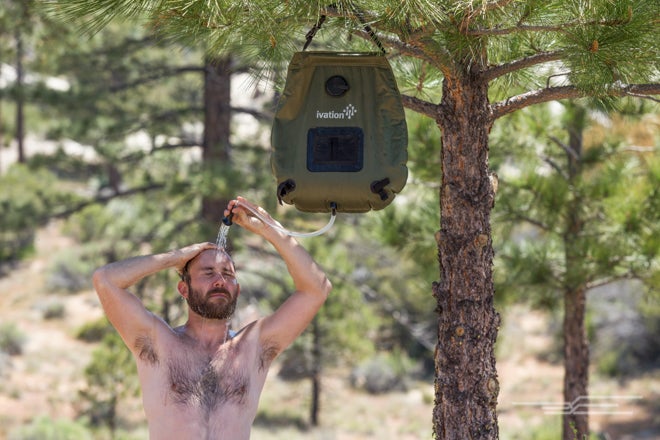
This post was done in partnership with The Wirecutter, a buyer’s guide to the best technology. Read the full article here.
After a long day on the trail, taking a hot shower could be nothing more than wishful thinking if you don’t have running water. But if you’re a fair-weather camper in a sunny location, the Ivation 5-Gallon Outdoor Portable Shower could change that. After a combined 12 hours of research and testing six different models, it has a longer shower time–close to eight minutes–than almost anything else we tested without compromising water pressure or turning into a cumbersome blob of water that’s impossible to lift or fill.
Sturdy construction and a threaded inlet cap that doesn’t burst open after you fill the bladder with water make the Ivation a little burlier than the competition. In addition, our pick has a plastic quick-release buckle on the handle, which made hanging the bag high enough to get adequate flow a lot easier. The Ivation also includes a threaded showerhead end so you can more precisely adjust that flow.
The key difference between the Advanced Elements 5-Gallon Summer Shower and our main pick is the Ivation’s threaded showerhead. The Advanced Elements shower uses a pull-on/push-off head that is perfectly functional, but not as precise as the Ivation’s in terms of adjusting water flow. But if it’s unavailable or the price jumps, our runner-up choice is nearly identical in every other way (and it comes with a handy, pre-attached shaving mirror—a nice bonus).
A favorite among our beach-going testers, the Nemo Helio Pressure Shower is a good pick for anyone that wants an upgrade in usability over a solar shower that you have to lift and hang to use. The Helio holds 3 gallons of water that are pressurized with a foot pump, so rinsing sand off of things like surfboards, sandals, beach toys, and kids with the included sprayer nozzle becomes quick and easy.
Why should you trust us?
Seamus Bellamy has been reviewing professionally for years and has used camp showers dozens of times after long days on damp trails in Nova Scotia and Spain. Additional research was contributed by Chris Dixon, who compared camp showers and sprayers in our beach and pool guide. Chris is the founding online editor of Surfer magazine.
Our pick
To use the Ivation, fill it up with water from whatever source you have handy (you can even top it off before leaving your house). To heat the water up, provided the weather’s warm, leave the Ivation out in the sun for a few hours. The makers of most of these showers offer a warning that, depending on how hot it is outside, the water in the shower’s bladder can get hot enough to scald you. While this is a reasonable caution, in practice, we found that the bigger hazard is that the water won’t get hot enough (more on that below).
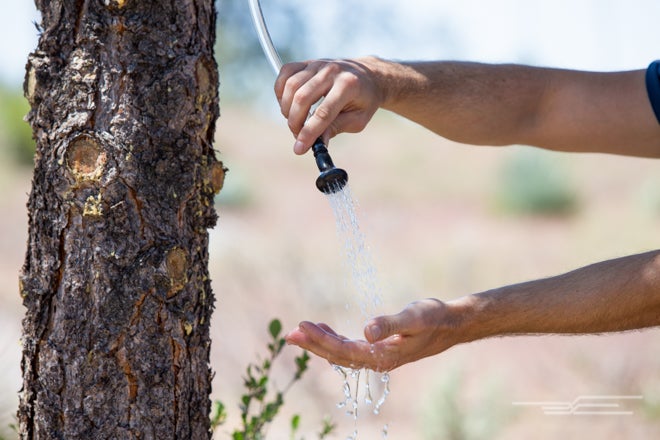
When you’re ready to use the Ivation, attach it somewhere above your head so that the water will flow into the shower’s hose easily. To start the water, give the shower head a twist. A twist in the opposite direction will shut it off again. Simple.
The Ivation Portable Outdoor Shower holds 5 gallons of water. Thanks to gravity and a well-designed shower head, we measured its runtime at 7 minutes and 22 seconds—enough time to rinse off after a dip in the ocean or hose down your kids before letting them into your tent for a nap. It provides a stream powerful enough to rinse dried dirt from a set of hiking boots, but like most camp showers, it isn’t pressurized. You’ll need gravity to make the water flow. Hanging it high enough so the 2-foot-long hose hangs down over your head is your best bet for making the water-magic happen.
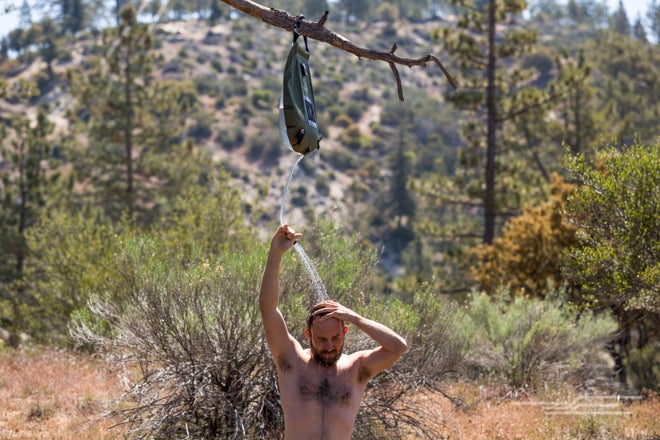
The Ivation has a strong, woven nylon handle with a side-attached buckle built in. This makes it possible to open the handle, sling it around a smallish branch or pole, and hang the camp shower up without having to lash it in place with a rope. But if you do decide to use rope, in addition to being able to string it through the Ivation’s handle, there’s also a pair of lashing points on the bladder.
The bladder is pretty tough. Don’t get us wrong, you could easily cut it with a knife or puncture it. But its four-ply PVC construction is durable enough that if you treat it with respect, it won’t tear or come apart at the seams under the weight of the water inside. When you need to refill the bladder, a wide, screw-top cap makes it easy to do so, and we preferred it to the friction cap on Coleman’s 5-Gallon Sun Shower, which continually popped open during our testing, disqualifying an otherwise decent product.
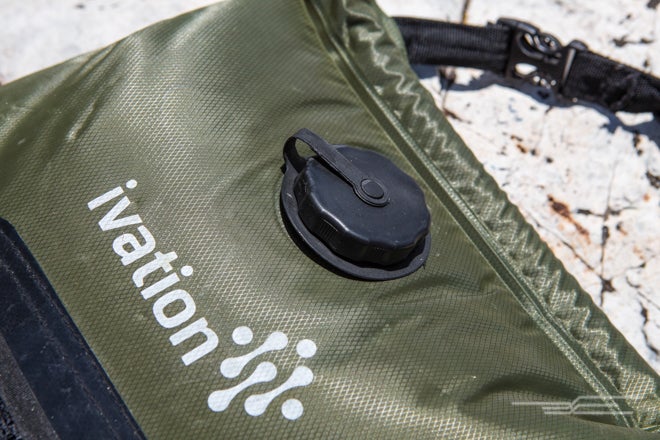
Of course, the whole point of a camp shower is to have a hot shower. And for that, your mileage may vary according to our tests, depending on outside conditions. All camp showers heat up the same way: you fill them with water and you lay them in the sun. So you need sun, and having a warm day helps. We found that nearly all the showers got up to around 100 to 105 degrees after about three hours in direct sunlight on an 80-degree afternoon. That’s warm, not hot, and a good bit less than the 112 degrees that experts say is ideal for cleaning and coziness.
Flaws but not dealbreakers
We’ve got two complaints with the Ivation. First, it can be difficult to turn the shower head on, especially when your hand is wet. On a number of occasions, we had to use two hands in order to get the water flowing. On other occasions, we could twist the shower head on with nothing more than a thumb and a forefinger. But being difficult to turn on isn’t so bad; if nothing else, that makes the shower less likely to leak while it’s in your car.
Second, we weren’t thrilled with its wee built-in shower caddy. It’s supposedly for stashing a travel bottle of shampoo or Campsuds into. But the twin pockets in the caddy were so tight once the Ivation’s bladder was filled that we could barely fit the fob on a set of car keys into it.
Runner-up
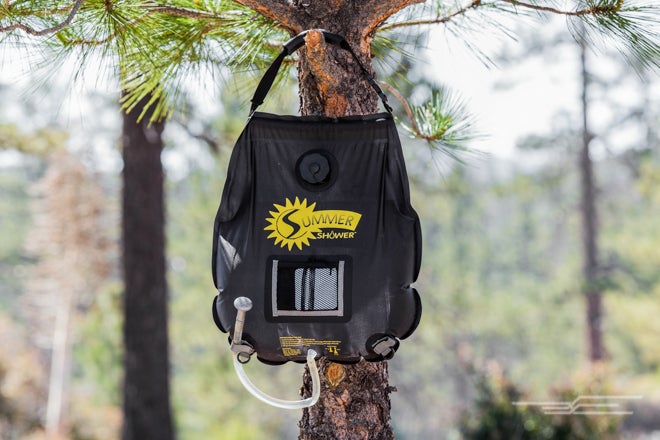
The Advanced Elements 5-Gallon Summer Shower is almost identical to our pick but lacks the Ivation’s simpler twist on shower head. We found the pros and cons similar; the runtime on the 5-gallon is adequate for showering, and the mesh front pocket is mostly useless when the bladder is full. In our tests, it heated water at an almost identical rate.
Advanced Elements makes their solar shower in a few different sizes, but we think 5 gallons is the way to go. We tested a bladder half the size, the Advanced Elements 2.5-Gallon Solar Shower. It’s is easier to carry and heats a bit quicker, but it only provided 2 minutes and 45 seconds of running water, which is not a lot of runtime.
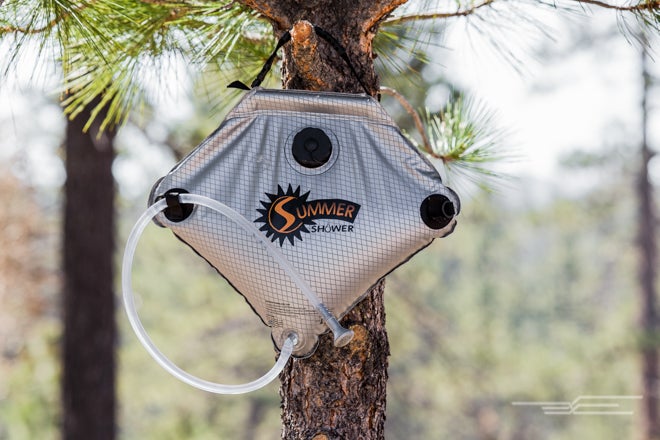
Upgrade pick
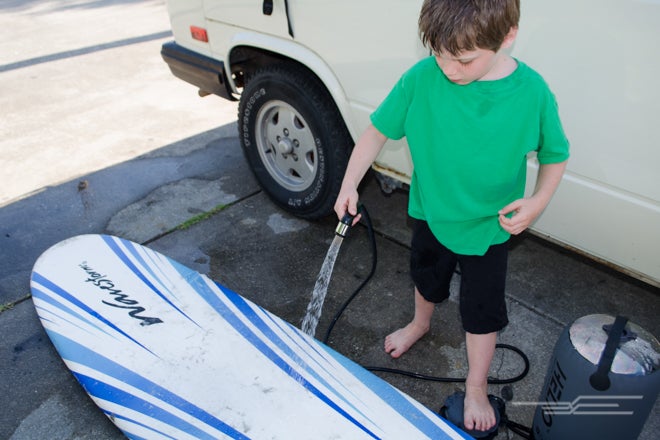
While its comparatively high price to our top pick might make it seem like more of a luxury, the Nemo Helio Pressure Shower is a good pick for anyone that doesn’t want to or is incapable of lifting the weight of a water-laden gravity shower like the Ivation. The Helio holds 3 gallons of water and is set up on the ground. Filling it up is easy, thanks to the nozzle built into the top of its bladder. In order to pressurize it, just pump it a few times with its built-in foot bellows. You won’t get in-house levels of water pressure, but the flow was more forceful than the gravity-fed models we tested. During testing, we found that the shower will run for minutes at a time but requires that you pump it a few times as you use it in order to keep the water flowing. It’s important to note that the Helio isn’t a solar-heated shower, per se. But in testing, a few hours in the sun got the temperature of the water up to 90 degrees—a bit warmer than a well-heated swimming pool.
How we picked and tested, and a look at the competition
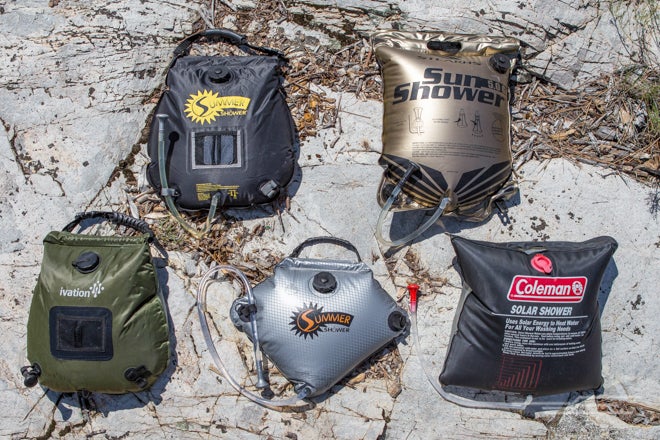
We scanned sites like Amazon, Bass Pro Shops, and REI to get a look at what’s out there, then also looked at this study by the Florida Solar Energy Center, which examined several factors that influence how quickly and how hot solar showers can get.
After 8 hours of research, we came to the conclusion that paying over $40 nets features that occasional weekend campers don’t need, but spending less than $20 isn’t a great idea either. It almost guarantees you’ll get equipment that smells like an old raincoat and feels like it’s made from the same flimsy stuff as a clown-shaped punching bag.
We selected six camp showers that offered different features, were made from different materials, promised strong water pressure, and appeared to be easy to carry when loaded to capacity. And then we used them in a variety of locations with different air temps and levels of sun exposure, including Canada, South Carolina, and Los Angeles.
We examined how easy they were to fill, how well-made they were, and how each one felt to carry while they were full of water. We also filled each one to capacity and timed how long they took to drain, while taking into consideration whether there was adequate water pressure for bathing. We paid close attention to how easy each shower was to turn on and off and how well extras like pockets and velcro worked.
We also paid attention to the size of the thing. A camp shower should have a large enough bladder to hose down without running out of water but still be light enough you don’t get a hernia hauling it up a tree on a rope or throwing it on top of your car to be heated in the sun.
Since one gallon of water weighs just over 8 pounds, a 5-gallon bladder (that’s 40 pounds of water) is a good compromise. Combined with a reasonably sized showerhead, the 5-gallon size should provide you with enough water that you have enough time to rinse off after soaping up.
We also tested to see how hot a solar shower can get. We did that by following manufacturer’s instructions, filling the bladders to capacity, and then laying them in direct sunlight on an 80-degree day in Los Angeles. We started with tap water that measured 77 degrees, using a ThermoWorks RT600c Pocket Thermometer, which is rated to work on both meat and liquids. All of the showers we tested, except the Coleman, have clear plastic on one side, and recommend facing the clear side toward the sun; the Coleman’s heating side is black, theoretically to gather more heat. With the exception of the Coleman, all of the showers came with built-in temperature gauges that provided rough accuracy at best.
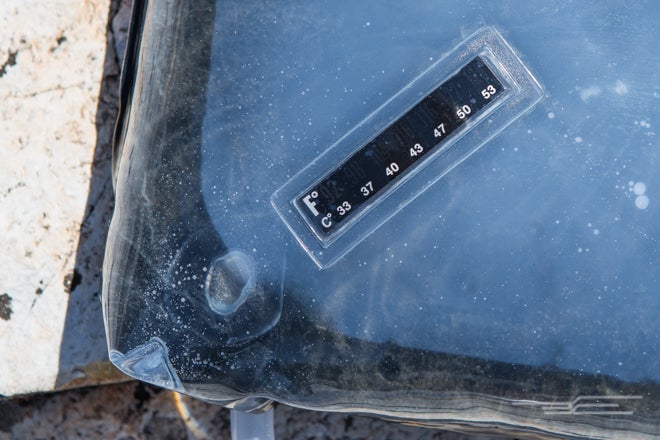
Overall, our testing found that all of the showers heated similarly. (That’s thermodynamics for you.) A secondary conclusion was that the built-in thermometers were fairly useless if you expect them to give you an accurate water temp, though they worked well enough to give you a rough idea as to whether the water was warm enough.
| Shower | 1 Hour (measured/indicator temp) | 2 Hours | 3 Hours |
| Ivation | 86/<90 | 98/105 | 101/110 |
| Coleman | 89/NA | 99/NA | 103/NA |
| Stearns | 82/<90 | 99/104 | 101/104 |
| Advanced Elements 2.5 | 82/<90 | 105/104 | 101/104 |
| Advanced Elements 5 | 86/NA | 99/NA | 100/NA |
Nearly all the showers performed equally, taking about three hours to reach a temperature most would classify as “warm” on a Southern Californian afternoon where the ambient temperature ranged between 80 and 85 degrees, and water temperature started at 77.
Our results were very similar to a more detailed outdoor shower test conducted in 2004 by the Florida Solar Energy Center. In a paper detailing their results—and you should read this paper, because it pretty much will turn you into a solar shower geek, which is the thing you need to be—the researchers found that no shower could reach 105 degrees within three hours, that (sensibly) cooler ambient temperature both slowed and limited heat gain, and that the “performance of each shower is similar, with the major differences being reliability and quality.”
One other thing you should be aware of: the showers lose heat quickly. All of the products we tested dropped by a minimum of five degrees after being placed in the shade for an hour. For folks who like a shower first thing in the morning, that’s a big deal. Your best bet while camping is to get the shower into the sun as soon as you can, and take your shower as soon as its water temperatures reach 100 degrees or so.
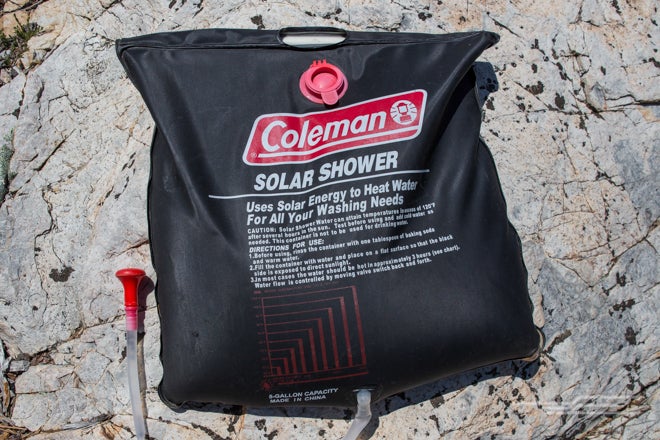
Of the other 5-gallon showers we looked at, the Stearns Sun Shower had potential, but once we filled it up with water, we noticed the PVC plastic around the handle was tearing under the weight. Its stream of water felt more powerful than the Ivation’s, but it ran dry in 5 minutes and 28 seconds. We’re happy to give up an iota of water pressure for the additional two minutes of runtime we got out of our pick. Coleman’s Sun Shower took close to twenty minutes for its bladder to drain because its water pressure was weak; worse, the product’s press-on cap kept popping open, leaking water everywhere (the other products we tested had a screw-on cap, which is much more secure). That’s too bad, because the Coleman’s black surface did mean it heated up a little more (and a little faster) than competing products. But the leaky cap is a dealbreaker.
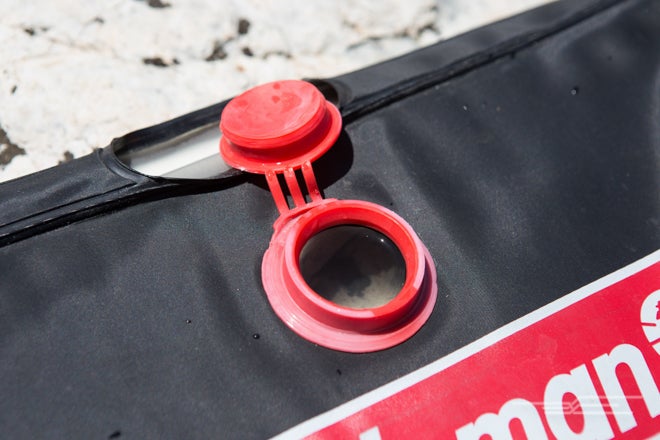
The 2.5-gallon Advanced Elements shower heated up faster (smaller showers generally do, according to the Florida report) but also cooled down quicker; and the capacity, while acceptable for solo campers, won’t work for families (who’ll probably use about 2.5 gallons per person per shower). The 5-gallon Advanced Elements looked and performed almost exactly like the Ivation and is a good choice if that one is out of stock.
This guide may have been updated by The Wirecutter. To see the current recommendation, please go here.